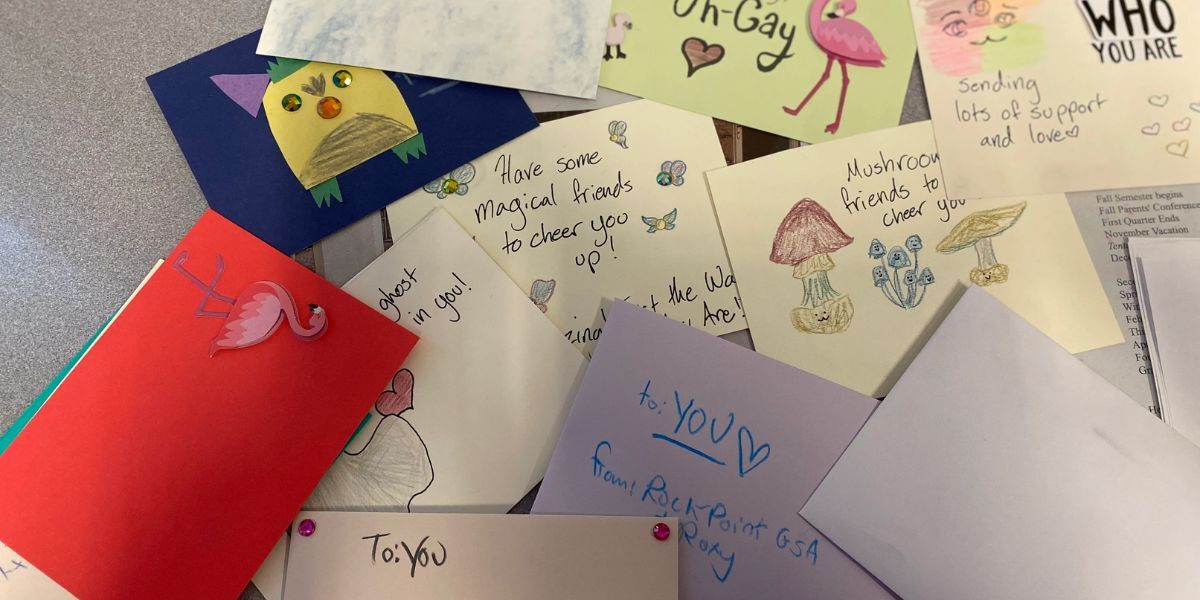Supporting Your Teen During School Breaks
As we are heading into our vacation, I am thinking about a student at Rock Point from many years ago who really struggled to get back into the school...

 In October, we hosted a discussion with local therapist and adoption specialist Benjamin Houchen on Adoption and Adolescents. We invited families in our community to join us to share insight and ask questions about how best to support teens who were adopted. While each family is unique, Houchen addressed the themes that emerge during adolescence and the particular significance they have for children who have been adopted.
In October, we hosted a discussion with local therapist and adoption specialist Benjamin Houchen on Adoption and Adolescents. We invited families in our community to join us to share insight and ask questions about how best to support teens who were adopted. While each family is unique, Houchen addressed the themes that emerge during adolescence and the particular significance they have for children who have been adopted.
These three themes (Identity, Inclusion, and Independence) explain a lot of the teen behaviors that can cause conflict. When you look for the root of the behavior, it can help you have empathy, stay connected to your child, and help resolve conflicts.
Identity
Every teen is seeking out their individual identity. For many teens this begins with their outward appearance - Am I tall? Am I fat? Am I attractive? How they feel about how they look is extremely important to adolescents and, when exploring their identity, their appearance is often the first thing they attempt to change. For children who have been adopted even this superficial identity seeking can be loaded with additional concerns such as, “Do I look like my biological family?”
As with all things, it is important the adults in the teenager’s life work on radical acceptance of the child. As much as you can, allow your teen to experiment with their identity and appearance, reaffirm that you love them no matter how they look, and try not to be more attached to their appearance than they are. After all, haircuts will grow out, hair dye will wash out, and fashions change. Setting some clear parameters can help, for example: “You can do whatever you like to your hair, but piercings and tattoos are permanent and you need to wait to make that choice when you are an adult.”
Deeper questions about identity may have to do with race, ethnicity, gender, sexuality, religion, or values. Teens may begin to create their own belief system that may be different than their parents. It can be harder to accept this kind of questioning and experimentation, but sometimes a strong negative reaction from a parent can make teens stick with something longer than they might otherwise. Having open discussions about these topics can help teens feel comfortable asking questions and sharing their own ideas. For children who have been adopted, they may be curious about their biological family’s beliefs, race, or country of origin - wondering if they identify with that culture. Again, the more honest you can be about your own comfort with this kind of discussion the more accepted your child will feel. For example, “I don’t actually know that much about Buddhism; maybe we can learn about it together.”
Inclusion
As humans, we naturally want to belong to a group and the first group we belong to is often our family. When children get older, they tend to seek approval and belonging from their peers. For adolescents, particularly adopted children or children with attachment issues, this sense of belonging can be increasingly important.
The need for inclusion may cause a teen to join groups through activities or clubs. Where the need for inclusion may become problematic is when the child might try a behavior that is dangerous, against the rules, or simply not something they actually want to do to feel part of a group or accepted by others. For children struggling with attachment, these behaviors can be extreme and they may cycle through many groups of friends.
To foster a positive sense of belonging, encourage your child to explore activities that interest them. Chances are, they will be able to find like-minded peers through healthy activities. Be open to allowing them to try new things! Keep reminding them that they are always a part of your family and make sure they feel they have a contributing role in the family.
Independence
Teenagers seek independence as part of their growth and development. They want to be able to make their own choices and try out their skills. This seeking of independence can take many forms from asking for more privileges to wanting to get a job. It can also take the form of a teen refusing to follow rules or acting out.
It can be very difficult to find a balance between protecting your child and allowing them the independence they need and crave. Teenagers at this stage often feel an external locus of control - in other words, the outside world controls them. At this stage, the concept of “Parenting in Baskets” coined by Dr. Ross Greene, can be helpful. With your child, try to put things in one of three baskets: things they can have control over (clothes, extracurriculars, room cleaning,etc.), things you will need to negotiate (using the car, curfew, screentime, chores, etc.), and things that are absolutely unacceptable for your family (drugs, reckless driving, etc.). This lets them know what they can control, while still setting reasonable limits.
Communication and Connection
One things that can be very difficult for teenagers and their families are strong emotional outbursts. Developmentally, teens exist more in their limbic (emotional) brain than adults and sometimes even simple requests can set off an emotional outburst.
While this can be frustrating, Houchen recommends you look at the outburst as a communication, rather than a behavior problem. For example, if your child says, “I hate school” and bursts into tears, it is helpful to be reflective and curious. Saying “I’m so sorry you hate school right now. What about it do you hate?” will get a conversation moving so you can help your child move through the emotions, discover what is at the root of them, and problem solve together.
In your communications with your child, the goal is to remain connected. Adopted children especially are sensitive to feelings of rejection and judgement. One method to stay connected while having challenging discussions is called “The PACE Model of Attachment Parenting” from Attachment Focused Parenting by Daniel Hughes. PACE is an acronym for Playfulness, Acceptance, Curiosity, and Empathy. Keeping these traits in mind when talking to your child will help keep you connected, even if you disagree.
This method is excellent for any communication, but is especially helpful when communicating with children and adolescents.
We really enjoyed having Benjamin Houchen present and look forward to hosting more discussions on adoption, adolescence, and other topics for parents and professionals. If you’re interested in attending future events, subscribe to our News & Events blog below!

As we are heading into our vacation, I am thinking about a student at Rock Point from many years ago who really struggled to get back into the school...

Every quarter, students choose from several electives, which meet three times a week to supplement the curriculum and provide a fun way to start...

“May your choices reflect your hopes, not your fears.” - Nelson Mandela